What Is the Critical Factor and Relationship of Urban Regeneration in a Historic District?: A Case of the Nanluoguxiang Area in Beijing, China
Abstract
:1. Introduction
2. Urban Regeneration in Conservation Areas of Beijing
2.1. Rehabilitation Policy in Historic and Cultural Conservation Areas in Beijing
2.2. Culture-Led Urban Regeneration in Beijing
3. Methods and Site Description
3.1. DEMATEL Method
- (1)
- Deduce the measurement elements and prepare a matrix survey table to review the subjects closely related to the study. The survey consists of a matrix survey table with a cause axis in a row and a result axis in columns. The question “How much is the affecting other factors factor (Some factors have independent personalities, while others have dependent personalities. As a result of the DEMATEL analysis, factors of an independent nature will be measured with low association with other factors, and factors of a dependent nature will be measured with high association with other factors)?” is asked. It is evaluated on a four-point scale according to the degree of influence.
- (2)
- Data in the form of nⅹn matrix are collected through investigation. The cause matrix and generalization matrix (A) are established directly by calculating the average for each element.
- (3)
- After the row and column sums of each matrix are obtained, a standardized matrix (X) is constructed by dividing the matrix by the largest of the two sum values. The largest of these is 1.(i, j= 1, 2, …, n)
- (4)
- The total-relation matrix (T) is the calculated considering direct causation and indirect causation.(i, j= 1, 2, …, n)
- (5)
- The relationship structure between elements is revealed by using the row and column sums of the total-relation matrix (T). The sum of rows (D) represents the influence on other elements, while the sum of the columns (R) indicates the extent to which other elements are affected. The importance of the whole element is calculated from the value of D+R. D-R is a value that distinguishes between causal and consequent tendency. If the value of D-R is positive, the causative tendency is strong. On the contrary, if the value of D-R is negative, the resultant tendency is strong.(i, j= 1, 2, …, n)
- (6)
- To visually analyze the influence structure between the elements, a two-dimensional graph can be created with the value of D+R as the X-axis and the value of D-R as the Y-axis. Using Jenks Natural Break technique (this method is one of the optimized methods for grading based on quantitative homogeneity and statistical cluster concept [36,37]. This technique minimizes the mean deviation and maximizes the deviation of the grades. The interval is determined by minimizing the variance in the grades and maximizing the variance between grades [38,39]), all the data from the total-relation matrix (T) are classified by score intervals, and the influence relationship is plotted in a two-dimensional graph.
3.2. Site Analysis
3.2.1. Site Introduce
3.2.2. Site Historicity
3.2.3. Urban Regeneration Project
3.3. Analysis of Urban Regeneration Contents and Factors
4. Result of Factors Causal Relationship Analysis
4.1. Data Collection and Respondents’ Features
4.2. Importance and Performance of Factors
4.3. Causal Relationship between Factors of Urban Regeneration Projects
4.3.1. Analysis of Influence Relationships between Important Factors before and after Urban Regeneration
4.3.2. Analysis of Influence Relationship between Important Factors in the Urban Regeneration Project
5. Conclusions and Discussion
Author Contributions
Funding
Acknowledgments
Conflicts of Interest
References
- Kim, H.-J. A Study on Shanghai’s Strategies for Cultural Urban Regeneration through Industrial Heritage—Focused on M50 Creative Industrial District; The Society of Chinese Studies: Seoul, Korea, 2013; pp. 321–347. [Google Scholar]
- Leary, M.E. The Routledge Companion to Urban Regeneration; Routledge: Abingdon, UK, 2013. [Google Scholar]
- Frith, S. Knowing one’s place: The culture of cultural industries. Cult. Stud. Birm. 1991, 1, 134–155. [Google Scholar]
- Evans, G.; Shaw, P. The Contribution of Culture to Regeneration in the UK: A Review of Evidence; DCMS: London, UK, 2004; p. 4. [Google Scholar]
- Sonn, J.W.; Chen, K.W.; Wang, H.; Liu, X. A top-down creation of a cultural cluster for urban regeneration: The case of OCT Loft, Shenzhen. Land Use Policy 2017, 69, 307–316. [Google Scholar] [CrossRef]
- Hu, Y.; Morales, E. The Unintended Consequences of a Culture-Led Regeneration Project in Beijing, China. J. Am. Plan. Assoc. 2016, 82, 148–151. [Google Scholar] [CrossRef]
- Xue, C.; Zheng, X.; Zhang, B.; Yuan, Z. Evolution of a multidimensional architectural landscape under urban regeneration: A case study of Jinan, China. Ecol. Indic. 2015, 55, 12–22. [Google Scholar] [CrossRef]
- Zhou, Z. Towards collaborative approach? Investigating the regeneration of urban village in Guangzhou, China. Habitat Int. 2014, 44, 297–305. [Google Scholar] [CrossRef]
- Fang, K. Contemporary Conservation in the Inner City of Beijing: Survey, Analysis and Investigation; Chinese Architecture and Building Press: Beijing, China, 2000. (In Chinese) [Google Scholar]
- Zhai, B.; Ng, M.K. Urban regeneration and social capital in China: A case study of the Drum Tower Muslim District in Xi’an. Cities 2013, 35, 14–25. [Google Scholar] [CrossRef]
- Wu, B.; Liu, L.; Shao, J.; Morrison, A.M. The evolution and space patterns of hutongtels in Beijing historic districts. J. Herit. Tour. 2015, 10, 129–150. [Google Scholar] [CrossRef]
- Zhang, S.H.; de Roo, G. Interdependency of self-organisation and planning: Evidence from Nanluoguxiang, Beijing. Town Plan. Rev. 2016, 87, 253–274. [Google Scholar] [CrossRef]
- Shin, H.B. Urban conservation and revalorisation of dilapidated historic quarters: The case of Nanluoguxiang in Beijing. Cities 2010, 27, S43–S54. [Google Scholar] [CrossRef]
- Rodwell, D. Conservation and Sustainability in Historic Cities, 1st ed.; Blackwell Publ.: Malden, MA, USA, 2007. [Google Scholar]
- Su, X. Urban conservation in Lijiang, China: Power structure and funding systems. Cities 2010, 27, 164–171. [Google Scholar] [CrossRef]
- Heath, T.; Oc, T.; Tiesdell, S. Revitalising Historic Urban Quarters; Routledge: London, UK, 2013. [Google Scholar]
- Graham, B. Heritage as knowledge: Capital or culture? Urban Stud. 2002, 39, 1003–1017. [Google Scholar] [CrossRef]
- Mowforth, M.; Munt, I. Tourism and Sustainability: Development, Globalisation and New Tourism in the Third World; Routledge: London, UK, 2015. [Google Scholar]
- Yue, Z. Steering Towards Growth: Symbolic Urban Preservation in Beijing, 1990–2005. Town Plan. Rev. 2008, 79, 187. [Google Scholar]
- Yung, E.H.K.; Chan, E.H.W.; Xu, Y. Sustainable Development and the Rehabilitation of a Historic Urban District—Social Sustainability in the Case of Tianzifang in Shanghai. Sustain. Dev. 2014, 22, 95–112. [Google Scholar] [CrossRef]
- Larkham, P. Conservation and the City; Routledge: London, UK, 2002. [Google Scholar]
- Abramson, D.B. The aesthetics of city-scale preservation policy in Beijing. Plan. Perspect. 2007, 22, 129–166. [Google Scholar] [CrossRef]
- Whitehand, J.W.R.; Kai, G. Urban conservation in China: Historical development, current practice and morphological approach. Town Plan. Rev. 2007, 78, 643. [Google Scholar] [CrossRef]
- Chen, Y.; Yoo, S.; Hwang, J. Fuzzy Multiple Criteria Decision-Making Assessment of Urban Conservation in Historic Districts: Case Study of Wenming Historic Block in Kunming City, China. J. Urban Plan. Dev. 2017, 143, 05016008. [Google Scholar] [CrossRef]
- Zhong, S. Artists and Shanghai’s culture-led urban regeneration. Cities 2016, 56, 165–171. [Google Scholar] [CrossRef]
- Liu, X.; Han, S.S.; O’Connor, K. Art villages in metropolitan Beijing: A study of the location dynamics. Habitat Int. 2013, 40, 176–183. [Google Scholar] [CrossRef]
- Wang, J.; Li, S. The rhetoric and reality of culture-led urban regeneration—A comparison of Beijing and Shanghai, China. In Proceedings of the IFoU Conference Delft, Amsterdam, The Netherlands, 26–28 November 2009. [Google Scholar]
- Zhou, S.Y.; Zhang, S.B. Contextualism and Sustainability: A Community Renewal in Old City of Beijing. Sustainability 2015, 7, 747–766. [Google Scholar] [CrossRef]
- Dai, L.; Wang, S.; Xu, J.; Wan, L.; Wu, B. Qualitative Analysis of Residents’ Perceptions of Tourism Impacts on Historic Districts: A Case Study of Nanluoguxiang in Beijing, China. J. Asian Archit.Build. Eng. 2017, 16, 107–114. [Google Scholar] [CrossRef]
- Hsu, C.W.; Kuo, T.C.; Chen, S.H.; Hu, A.H. Using DEMATEL to develop a carbon management model of supplier selection in green supply chain management. J. Clean. Prod. 2013, 56, 164–172. [Google Scholar] [CrossRef]
- Dehdasht, G.; Zin, R.M.; Ferwati, M.S.; Abdullahi, M.; Keyvanfar, A.; McCaffer, R. DEMATEL-ANP Risk Assessment in Oil and Gas Construction Projects. Sustainability 2017, 9, 1420. [Google Scholar] [CrossRef]
- Gan, J.; Luo, L. Using DEMATEL and Intuitionistic Fuzzy Sets to Identify Critical Factors Influencing the Recycling Rate of End-of-Life Vehicles in China. Sustainability 2017, 9, 1873. [Google Scholar] [CrossRef]
- Seker, S.; Zavadskas, E.K. Application of fuzzy DEMATEL method for analyzing occupational risks on construction sites. Sustainability 2017, 9, 2083. [Google Scholar] [CrossRef]
- Chou, Y.C.; Yang, C.H.; Lu, C.H.; Dang, V.; Yang, P.A. Building Criteria for Evaluating Green Project Management: An Integrated Approach of DEMATEL and ANP. Sustainability 2017, 9, 740. [Google Scholar] [CrossRef]
- Akyuz, E.; Celik, E. A fuzzy DEMATEL method to evaluate critical operational hazards during gas freeing process in crude oil tankers. J. Loss Prev. Process Ind. 2015, 38, 243–253. [Google Scholar] [CrossRef]
- North, M.A. A method for implementing a statistically significant number of data classes in the Jenks algorithm. In Proceedings of the 2009 Sixth International Conference on Fuzzy Systems and Knowledge Discovery, Tianjin, China, 14–16 August 2009. [Google Scholar]
- Smith, R.M. Comparing Traditional Methods for Selecting Class Intervals on Choropleth Maps. Prof. Geogr. 1986, 38, 62–67. [Google Scholar] [CrossRef]
- Jenks, G.F. The data model concept in statistical mapping. Int. Yearb. Cartogr. 1967, 7, 186–190. [Google Scholar]
- McMaster, R.J.C. In Memoriam: George F. Jenks (1916–1996). Cartogr. Geogr. Inf. Syst. 1997, 24, 56–59. [Google Scholar] [CrossRef]
- Li, T.; Zhang, E. The History of Nanluoguxiang; Beijing Publishing House: Beijing, China, 2010; pp. 2–180. (In Chinese) [Google Scholar]
- Beijing Municipal City Planning Commission. Conservation Planning of 25 Historic Areas in Beijing Old City; Yanshan Press: Beijing, China, 2002. (In Chinese) [Google Scholar]
- Wu, L. Rehabilitating the Old City of Beijing: A Project in the Ju’er Hutong Neighbourhood; UBC Press: Vancouver, BC, Canada, 1999. [Google Scholar]
- Martilla, J.A.; James, J.C. Importance-Performance Analysis. J. Mark. 1977, 41, 77–79. [Google Scholar] [CrossRef]
- Zukin, S. Loft living as ‘historic compromise’ in the urban core: The New York experience. Int. J. Urban Reg. Res. 1982, 6, 256–267. [Google Scholar] [CrossRef]
- Zukin, S. Gentrification: Culture and Capital in the Urban Core. Ann. Rev. Sociol. 1987, 13, 129–147. [Google Scholar] [CrossRef]
- Zukin, S. Loft Living: Culture and Capital in Urban Change; Johns Hopkins University Press: Baltimore, MD, USA, 1982. [Google Scholar]
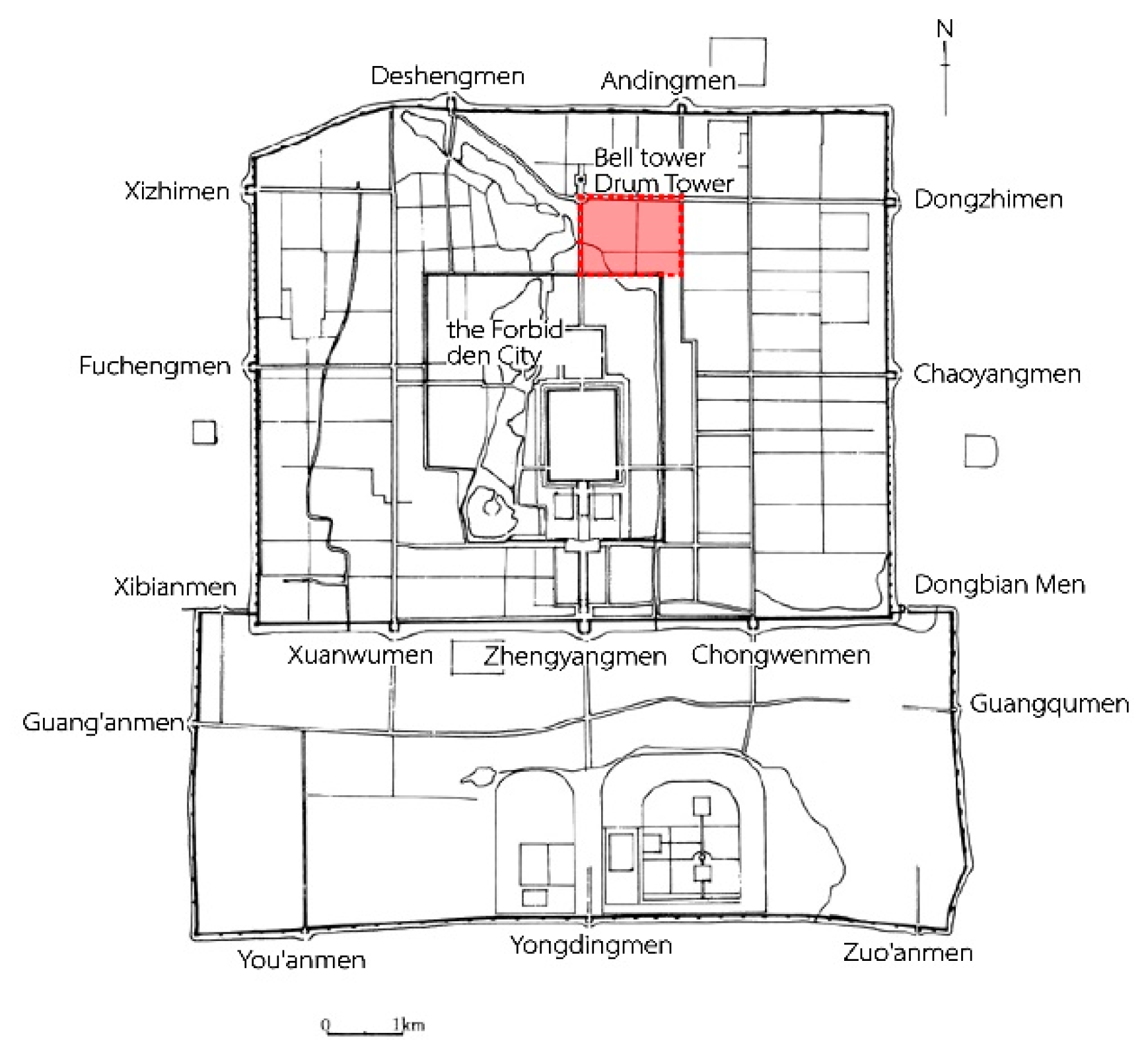
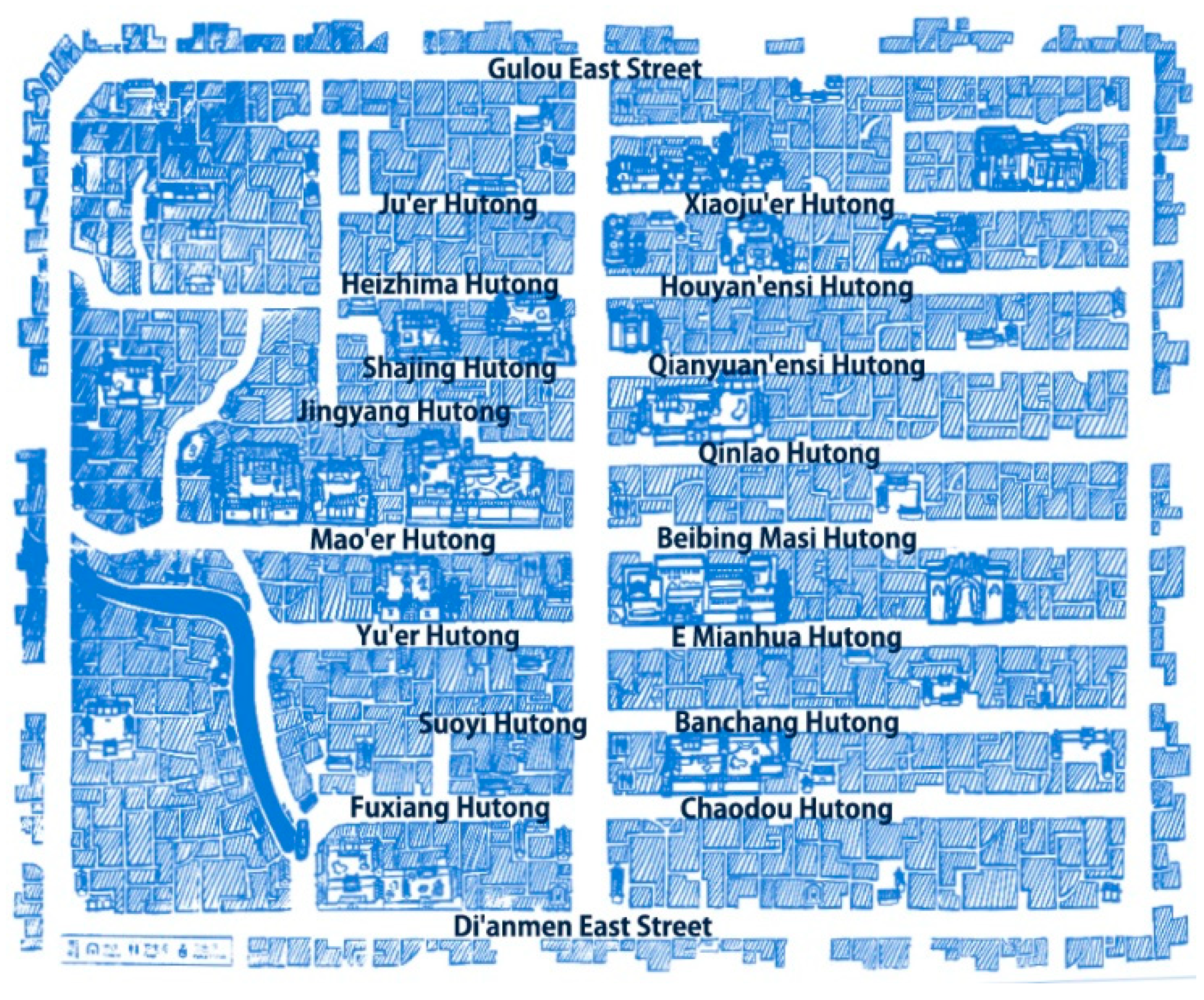

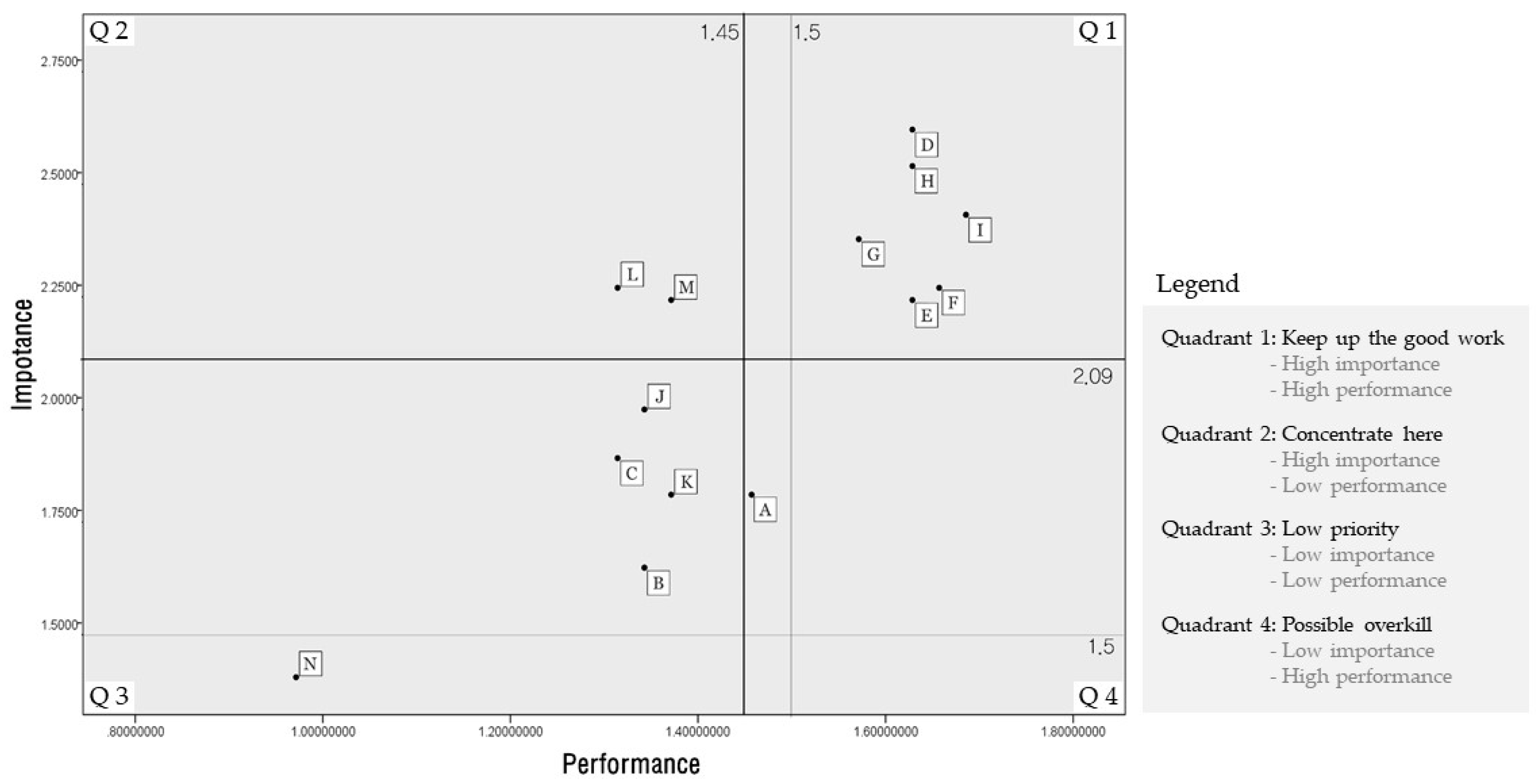
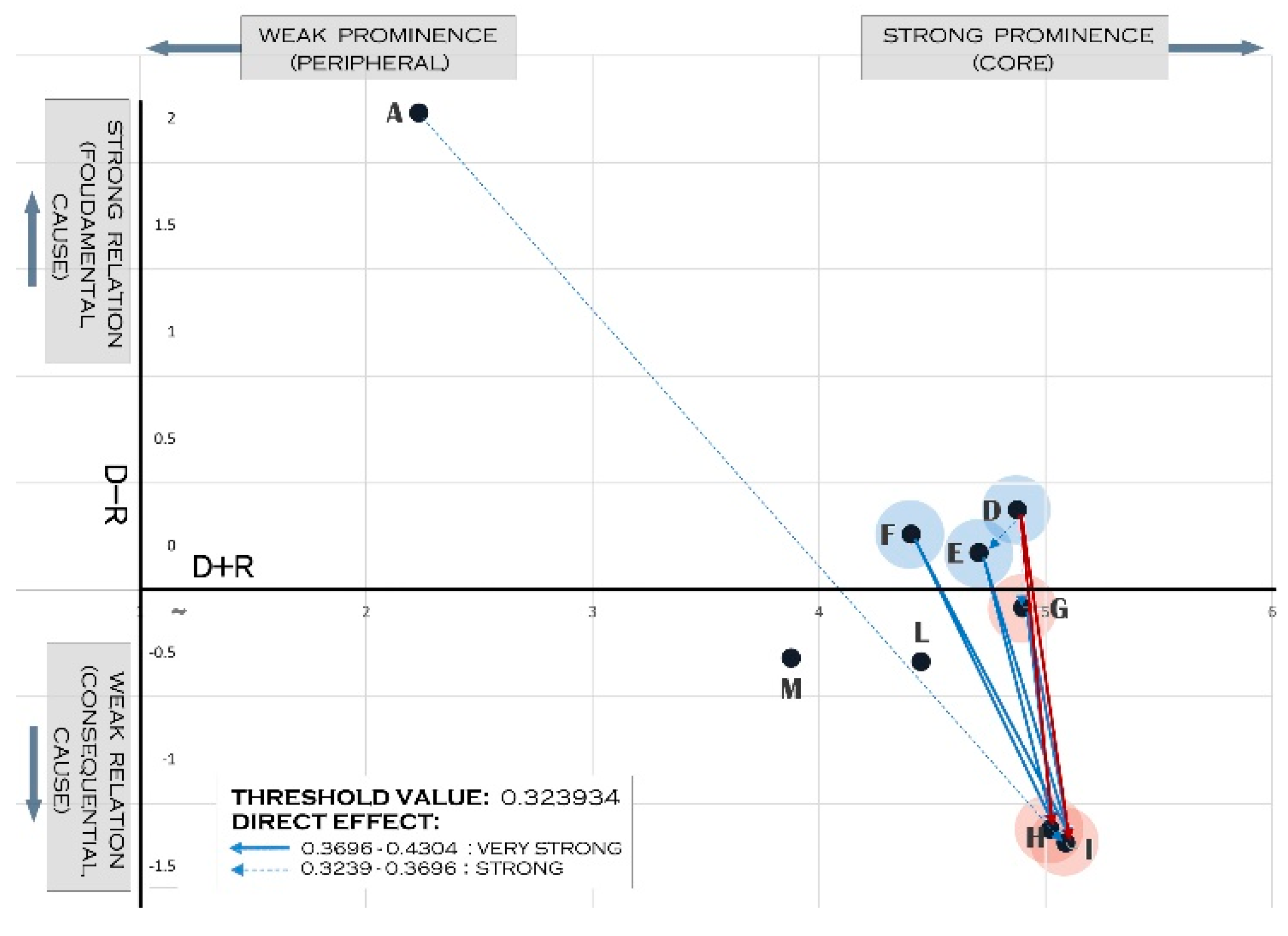
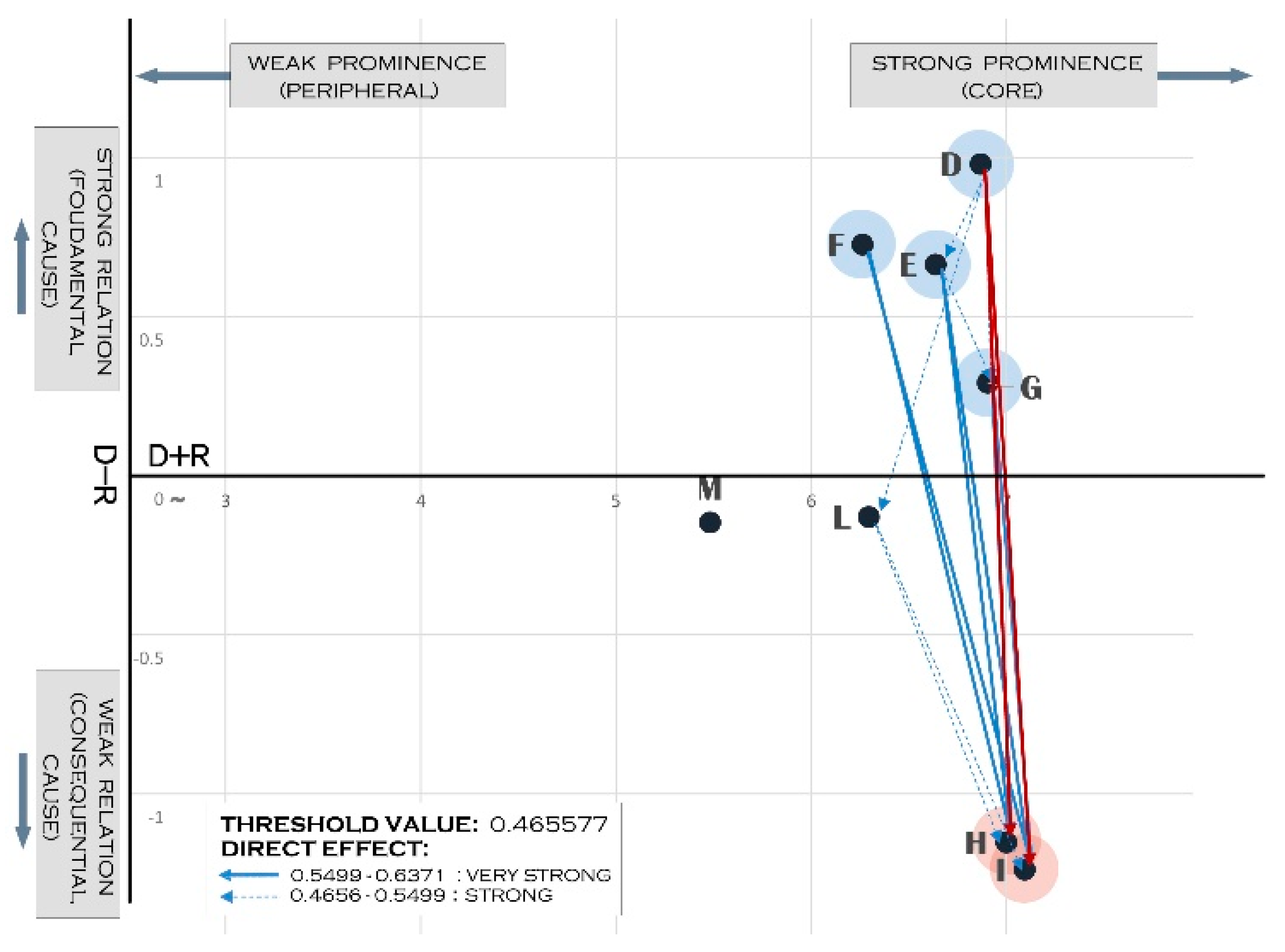
| Classification | Project Factors | Major Contents | |
|---|---|---|---|
| Previous project stage | A | Previous policies and plans | Old dangerous housing renovation plan, protection plan of 25 old towns in Beijing, the Nanluoguxiang regional integrated landscape plan, Beijing commercial specialized street development plan |
| B | Existing projects | Hutong and building renovation projects, demolition and renovation of obsolete housing, local greening project, art creative project, Siheyuan renovation project, etc. | |
| C | Preliminary investigations | Measurement of Siheyuan, Satisfaction and Opinion Survey on Community Restoration Project | |
| Preparation stage project | D | Policies and plans | 5 Years National Economic and Social Development Plan in Dongcheng District, Beijing; Compensation policies to attract relevant business; the Nanluoguxiang Area Protection and Development Plan (2006–2020); The Nanluoguxiang Ordinance for Protection of Historical and Cultural Streets; etc. |
| E | Guideline and criteria | Investment guide for historic and cultural protection areas, landscape protection plan execution criteria, guidelines for the protection of historic landscape and the modification of hazardous houses, criteria for the use of support and compensation for the guidance of commercial business, etc. | |
| F | Investigation and research | Survey and data collection for local buildings, regional asset research, survey and evaluation of local projects, research to protect historicity, and a sustainable urban regeneration and community awareness survey | |
| G | Subsidy Support Project | Financial support to improve infrastructure, subsidies, and rewards to attract businesses | |
| Physical projects | H | Public Space Environmental Improvement Project | Public Space Environmental Improvement Project, hutong-area greening and beautification business, public safety project, lighting installation business, road improvement and historic restoration project of major streets, parking lot improvement business, etc. |
| I | Building Restoration and Improvement Project | Comprehensive restoration project for local historical sites, old roads, and historical buildings, hutong restoration project, restoration project of central street environment, renovation of local assets, and demolition project of illegal buildings on Jiaodaokou streets | |
| Non-physical projects | J | Cultural Arts Project | Creative activities in collaboration with local arts organizations, exhibition and art sales, creative art market, sales of local residents’ handicrafts, etc. |
| K | Community Participation Support Project | Support group for the local elderly, good parent activity organizations, old neighborhood organizations, supporting environmental protections of public activities in old neighborhoods | |
| Local residents participation and empowerment | L | Collecting residents’ opinions | Open space resident meetings, community tea house forums, the Nanluoguxiang development seminars, the area construction management planning conferences |
| M | Activities for self-governing residents’ organizations | Merchants’ associations, self-governing organization of local community, survey of Jiaodaokou street residents’ opinions, firefighting teams, security and traffic patrols, publicity handbooks and book publications, and website operation | |
| N | Empowerment for merchants and residents | Store system and policy education to strengthen merchant capacity, sign Language education, English conversation education, vocational and functional education for local residents, and startup programs | |
| Responder Characteristic | Number | (%) | |
|---|---|---|---|
| Length of career | Less than 5 years | 2 | 4.9 |
| Less than 10 years | 11 | 26.8 | |
| Less than 15 years | 9 | 22.0 | |
| More than 15 years | 19 | 46.3 | |
| Job type occupation | Experts (planner, professor, researcher) | 10 | 24.4 |
| Working-level planner | 13 | 31.7 | |
| Local merchants, social enterprises | 2 | 4.9 | |
| Property owners, local residents | 6 | 14.6 | |
| Local officials | 10 | 24.4 | |
| Factors of Urban Regeneration | Average Important | Average Performance | |
|---|---|---|---|
| A | Previous policy and plan | 1.81 | 1.45 |
| B | Existing projects | 1.64 | 1.34 |
| C | Preliminary investigation | 1.89 | 1.31 |
| D | Policies and plans | 2.54 | 1.62 |
| E | Guideline and criteria | 2.24 | 1.62 |
| F | Investigation and research | 2.27 | 1.65 |
| G | Subsidy Support Project | 2.35 | 1.57 |
| H | Public Space Environmental Improvement Project | 2.51 | 1.62 |
| I | Building Restoration and Improvement Project | 2.37 | 1.68 |
| J | Cultural Arts Project | 2.00 | 1.34 |
| K | Community Participation Support Project | 1.81 | 1.37 |
| L | Collecting residents’ opinions | 2.24 | 1.31 |
| M | Activities for self-governing residents’ organizations | 2.18 | 1.37 |
| N | Empowerment for merchants and residents | 1.37 | 0.97 |
| Total average | 2.09 | 1.44 | |
| A | D | E | F | G | H | I | L | M | D | R | D + R | D − R | |
|---|---|---|---|---|---|---|---|---|---|---|---|---|---|
| A | 0.00 | 0.286 | 0.272 | 0.226 | 0.284 | 0.343 | 0.348 | 0.247 | 0.222 | 2.233 | 0.000 | 2.233 | 2.233 |
| D | 0.00 | 0.210 | 0.328 | 0.287 | 0.346 | 0.419 | 0.430 | 0.323 | 0.280 | 2.624 | 2.250 | 4.875 | 0.374 |
| E | 0.00 | 0.292 | 0.197 | 0.266 | 0.317 | 0.393 | 0.409 | 0.307 | 0.255 | 2.440 | 2.265 | 4.706 | 0.174 |
| F | 0.00 | 0.283 | 0.279 | 0.176 | 0.313 | 0.369 | 0.378 | 0.287 | 0.244 | 2.333 | 2.073 | 4.407 | 0.260 |
| G | 0.00 | 0.269 | 0.270 | 0.269 | 0.215 | 0.398 | 0.403 | 0.304 | 0.275 | 2.407 | 2.491 | 4.899 | −0.084 |
| H | 0.00 | 0.232 | 0.225 | 0.208 | 0.259 | 0.216 | 0.336 | 0.249 | 0.221 | 1.950 | 3.070 | 5.021 | −1.120 |
| I | 0.00 | 0.231 | 0.231 | 0.205 | 0.265 | 0.324 | 0.222 | 0.247 | 0.225 | 1.953 | 3.137 | 5.090 | −1.183 |
| L | 0.00 | 0.244 | 0.252 | 0.232 | 0.266 | 0.323 | 0.321 | 0.179 | 0.236 | 2.057 | 2.392 | 4.450 | −0.335 |
| M | 0.00 | 0.200 | 0.207 | 0.200 | 0.222 | 0.282 | 0.285 | 0.244 | 0.135 | 1.779 | 2.097 | 3.877 | −0.318 |
| D | E | F | G | H | I | L | M | D | R | D + R | D − R | |
|---|---|---|---|---|---|---|---|---|---|---|---|---|
| D | 0.347 | 0.478 | 0.425 | 0.511 | 0.621 | 0.637 | 0.482 | 0.419 | 3.924 | 2.943 | 6.868 | 0.980 |
| E | 0.429 | 0.327 | 0.395 | 0.471 | 0.582 | 0.603 | 0.456 | 0.385 | 3.650 | 2.986 | 6.636 | 0.664 |
| F | 0.415 | 0.413 | 0.292 | 0.462 | 0.549 | 0.563 | 0.429 | 0.369 | 3.495 | 2.768 | 6.263 | 0.727 |
| G | 0.403 | 0.406 | 0.397 | 0.356 | 0.584 | 0.593 | 0.451 | 0.405 | 3.598 | 3.305 | 6.904 | 0.293 |
| H | 0.342 | 0.337 | 0.311 | 0.382 | 0.358 | 0.492 | 0.370 | 0.327 | 2.923 | 4.075 | 6.999 | −1.152 |
| I | 0.342 | 0.343 | 0.308 | 0.390 | 0.476 | 0.366 | 0.367 | 0.331 | 2.927 | 4.165 | 7.093 | −1.238 |
| L | 0.361 | 0.371 | 0.342 | 0.396 | 0.482 | 0.483 | 0.297 | 0.349 | 3.082 | 3.212 | 6.295 | −0.129 |
| M | 0.300 | 0.308 | 0.295 | 0.334 | 0.420 | 0.426 | 0.355 | 0.225 | 2.667 | 2.813 | 5.481 | −0.146 |
© 2019 by the authors. Licensee MDPI, Basel, Switzerland. This article is an open access article distributed under the terms and conditions of the Creative Commons Attribution (CC BY) license (http://creativecommons.org/licenses/by/4.0/).
Share and Cite
Zhang, Y.; Kang, S.; Koo, J.-H. What Is the Critical Factor and Relationship of Urban Regeneration in a Historic District?: A Case of the Nanluoguxiang Area in Beijing, China. Sustainability 2019, 11, 6772. https://doi.org/10.3390/su11236772
Zhang Y, Kang S, Koo J-H. What Is the Critical Factor and Relationship of Urban Regeneration in a Historic District?: A Case of the Nanluoguxiang Area in Beijing, China. Sustainability. 2019; 11(23):6772. https://doi.org/10.3390/su11236772
Chicago/Turabian StyleZhang, Yuqi, Sungik Kang, and Ja-Hoon Koo. 2019. "What Is the Critical Factor and Relationship of Urban Regeneration in a Historic District?: A Case of the Nanluoguxiang Area in Beijing, China" Sustainability 11, no. 23: 6772. https://doi.org/10.3390/su11236772
APA StyleZhang, Y., Kang, S., & Koo, J.-H. (2019). What Is the Critical Factor and Relationship of Urban Regeneration in a Historic District?: A Case of the Nanluoguxiang Area in Beijing, China. Sustainability, 11(23), 6772. https://doi.org/10.3390/su11236772





